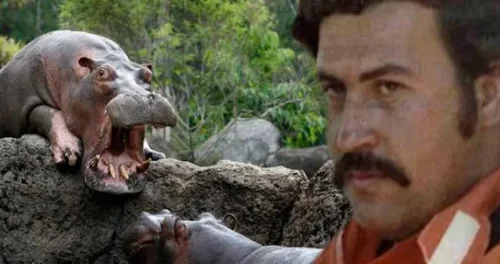Colombian drug lord Pablo Escobar had so much money that he literally could not spend it fast enough. He and the Medellín cartel he started dominated the cocaine trade in the 1980s. By then, he was earning about $420 million per week.
Storing piles of cash in fields and warehouses, he’d write off 10 percent of it each year (that’s more than $2 billion) accepting that it would inevitably be lost, destroyed by the elements, or eaten by rats.
Of his many palatial homes, the King of Cocaine’s favorite was a $63 million/7,000-acre estate called Hacienda Nápoles. The front gate was adorned with the actual plane Escobar used on his maiden voyage to the United States. But that was far from the only flourish. Hacienda Nápoles also featured:
- Bullfighting arena
- Soccer field
- Artificial lakes
- Airstrip
- Tennis courts
- Dinosaur statues
- Classic car collection
And then there was the private zoo for which Escobar imported four hippos in 1981. They became known as the “Cocaine Hippos.”
Some ten years after the hippos arrived in Colombia, Escobar was facing intense pressure from law enforcement. He arranged to turn himself in as long as he got to build his own jail. The authorities agreed and La Catedral was constructed. Telephones, fax machines, and computers were included but they were the least of the luxuries. This private penitentiary offered its elite inmate access to a sauna, waterfall, soccer field, and nightclub.
Upon learning that Escobar had tortured and killed two cartel members at La Catedral, a government plan was set in motion to transfer him to a less posh cell. The drug lord promptly escaped — going on the run with his family in July 1992. Legend has it that Pablo burned $2 million in cash just to keep his daughter warm while on the lam.
With help from the U.S., Pablo Escobar was eventually found and killed as he celebrated his 44th birthday on December 2, 1993. At the time of his death, his wealth was conservatively estimated at $30 billion — about $61.5 billion in 2022 dollars.
The Colombian government sold off Escobar’s assets and shipped away the zoo animals. Too complicated to deal with, the hippos were left to fend for themselves in the nation’s waterways.
Fast-forward to 2022: There are now as many as 100 cocaine hippos in Colombia. “Within a couple of decades,” predicts one researcher, “there could be thousands of them.”
Scientists initially viewed the hippos as an “invasive species,” but some serious second thoughts are being seriously had. You see, toward the end of the Pleistocene Epoch, the last large semiaquatic hoofed herbivore from that geographical area was driven into extinction by avaricious early humans. That creature’s official name was Trigonodops lopesi and it’s been called the “closest extinct equivalent to a modern hippo.”
So, thanks to a predatory drug lord and some inefficiency from the Colombian government, well… here’s how the folks at LiveScience.com explain it:
As big herbivorous animals vanished, their absence starved the soil of nutrients, altered plant growth, and even affected water flow and availability … However, newly introduced nonnative herbivores — such as Escobar’s ‘cocaine hippos’ — could revitalize and enrich such ecosystems.
It’s too early to assess the ecological impact of the cocaine hippos but their prodigious poop just may deliver the nutrients missing from that region for at least 11,000 years.
What’s the moral of this story? For starters, you might wanna try this one on for size:
Especially non-human life…












